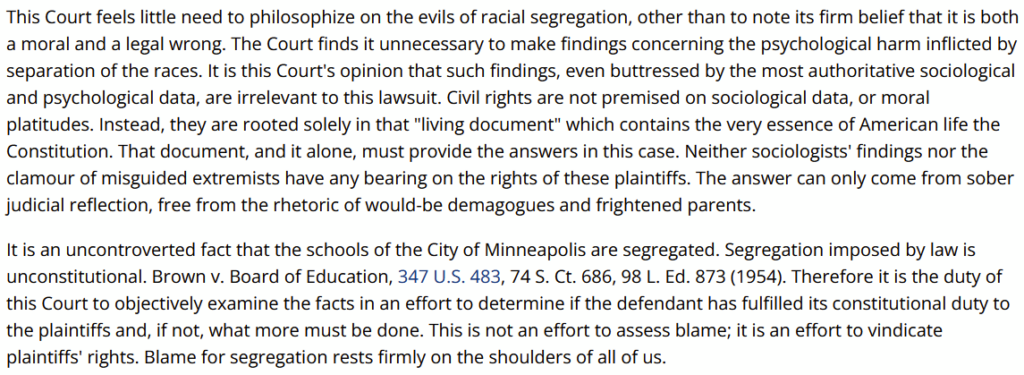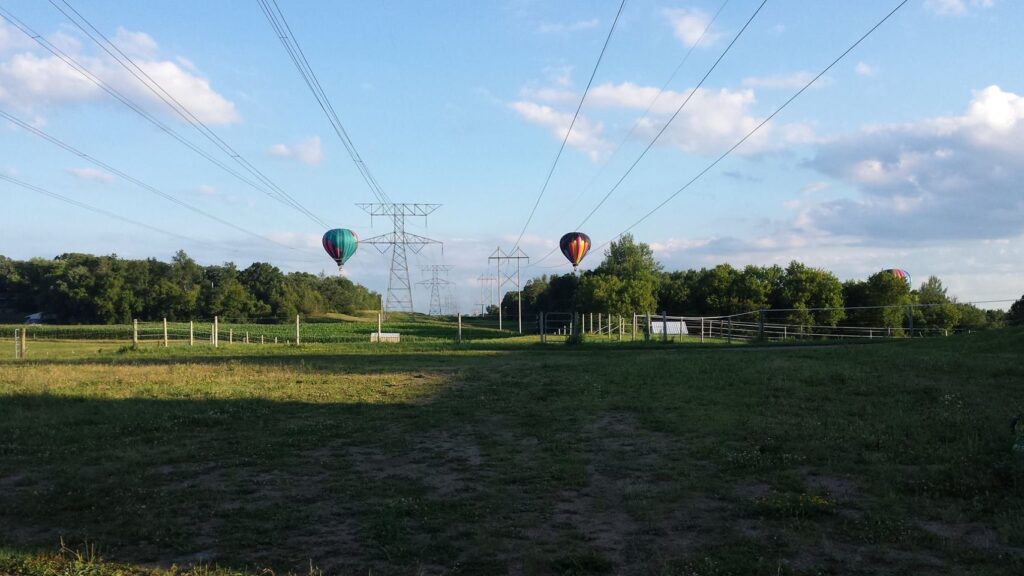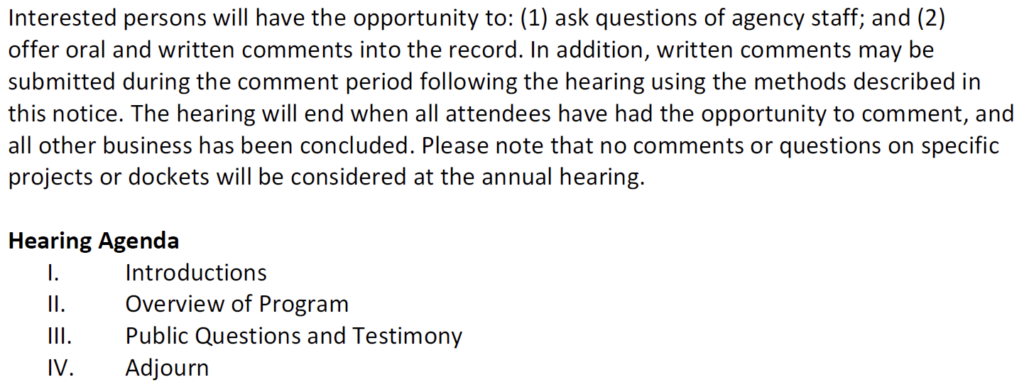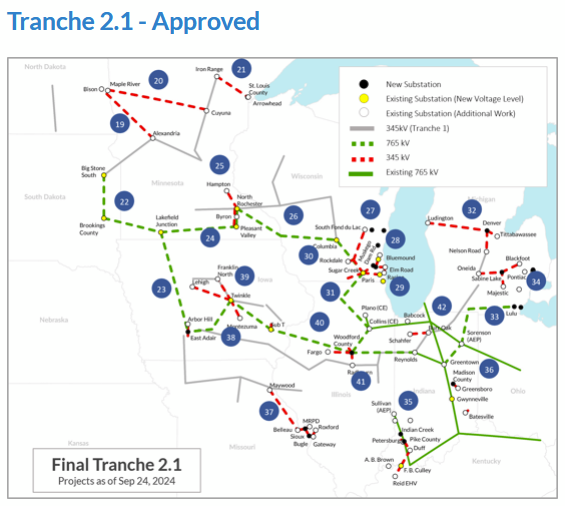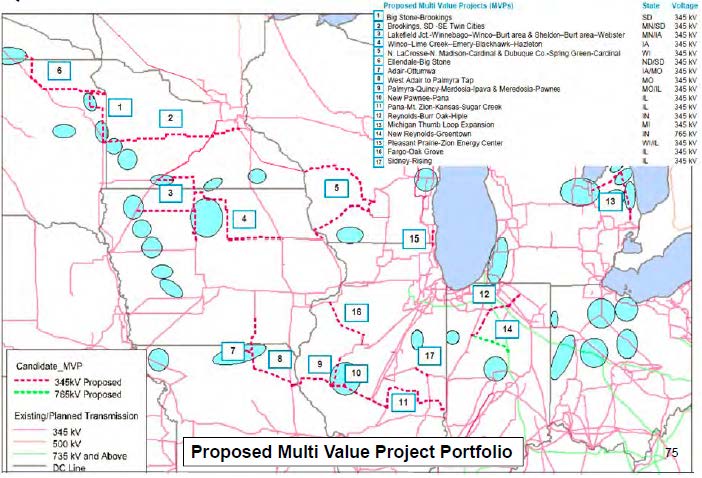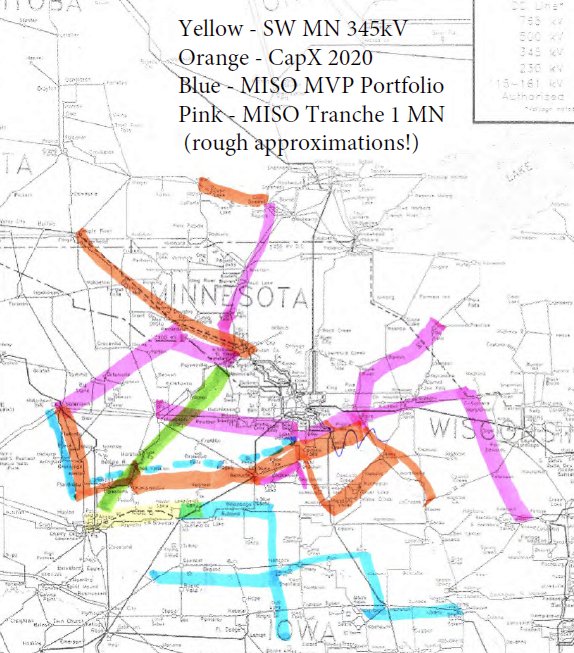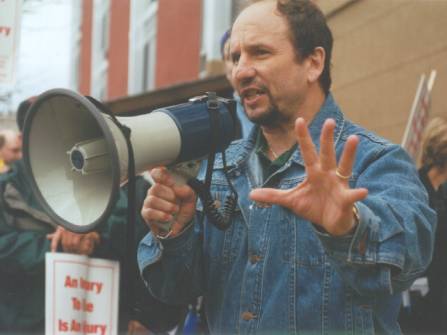OOPS! Missed notice, a hearing redo!
December 16th, 2025
Yes, OOPS! The Public Utilities Commission didn’t publish notice of the Annual Infrastructure Permitting Hearing as required by statute, so here it is — the full notice as published in the Current Monitor: December 16, 2025 Volume 49, Number 50, quoted in full:
Minnesota Public Utilities Commission – Annual Infrastructure Permitting Hearing
Notice description: On 12/9/2025, The Commission held the Annual Infrastructure Permitting Hearing under Minnesota Statute § 216I.15 – however, it was inadvertently missed that the notice was not submitted to the EQB Monitor. The 12/9/2025 recording of the hearing will be played at an additional, online only hearing via WebEx that will be held on December 29, 2025 at 10:30 AM. Information to join that meeting can be found on the PUC calendar on the date of the hearing, 12/9/2025, at: https://mn.gov/puc/about-us/calendar/. You can also find an updated version of the Notice in eDockets using the docket number 25-18, at: https://efiling.web.commerce.state.mn.us/ You can also join the WebEx meeting using the login information below.
Public meeting date, time, location: December 29, 2025, 10:30 a.m., Online meeting
Public meeting virtual link: Join online meeting
Public meeting additional details: Telephone: 1-855-282-6330
Event Password: PUC2025! (667820 when dialing from a phone)
Webinar Number: 2485 945 6472
Meeting video and audio are available via the internet. Logon five to 15 minutes before the meeting begins. You will be asked to join the meeting through a Webex application or through a plug-in for your web browser. You will be asked to enter your name and email address. Attendees will be muted. If you would like to ask a question or make a comment during the meeting, use the chat function to send a message to the meeting moderator. Your line will be unmuted, and you will be able to ask your question or make a comment. You may call in on your telephone and listen to the meeting. If you would like to ask a question or make a comment during the meeting, press *3 on your telephone. General information about attending a hearing using the WebEx platform can be found at: https://mn.gov/puc/activities/meetings/webex/
If you have questions about participating in the meeting or need assistance during the meeting, please contact Commission staff person Sam Lobby (details below).
Link to additional information: PUC infrastructure permitting additional information
Contact: Minnesota Public Utilities Commission, Sam Lobby, 651-201-2205
AUAR Guidance & Energy Infrastructure Rules
December 15th, 2025
From this week’s EQB Monitor, another “be there or be square” notice:
And here’s the kuve link for the meeting packet:
ERIS meeting webpage
Oh, how very Presidential…
December 15th, 2025
As if war, warS, murder on the high seas, violations of Constitution and law every day, disregard for people following the legal processes to become citizens, putting the country’s health at risk by pulling out health insurance out from under them, pardoning of J6 insurrectionists and criminals guilty of extreme fraud… etc., etc., etc., as if that wasn’t enough… this is clear enough for the world to recognize that Trump is an abhorrent POS:
Yes, just look at “this raging obsession of President Donald J. Trump, with his obvious paranoia reaching new heights…”
Of course I told him what I think in technicolor, by mail in my daily postcard and a letter with this screenshot (1600 Pennsylvania Ave, Washington, DC 20500), and calling both comment line (202) 456-1111 and switchboard (202) 456-1414 AND the contact form: https://www.whitehouse.gov/contact/
Your turn, you know what to do!
Sure, add me to the “Anti-Fascist” list — I’ll wear that label proudly.
Mpls Schools under Siege! HANDS OFF!
December 10th, 2025
Attention fellow Maggots! And everyone else who cares about education, the Minneapolis Public Schools, and preserving diversity in teaching:
Trump admin sues Minneapolis schools over layoff protections for teachers of color
DOJ’s Press Release
Here’s the Complaint:
Dept. of “Justice,” just how does this policy affect the public? Are there applicants standing in line applying to teach in Minneapolis Public Schools, and not being hired? If so, I’d imagine they’d be Plaintiffs. Do tell, specifically how is your lawsuit in the public interest?
The thought of this lawsuit makes my head explode. What can we do about it? Spread the word, and ?? I’m at a loss…
+++++++++++++++++++++++
Those of us who were there way back when — remember the beginnings of Central’s Magnet School?
Remember the lawsuit against the school district at that time, and remember the Consent Agreement hearings?
Booker v. SPECIAL SCHOOL DIST. NO. 1, MINNEAPOLIS, MINN., 351 F. Supp. 799 (D. Minn. 1972)
From that decision:
It’s interesting to read some of that history with 50+ years of hindsight. This history means a lot to me, it’s very personal and I get pretty worked up about it, because experience at Central opened doors for me and changed my idea of “education.” Central worked for both my brother and I, and I wonder if I would have even graduated if I hadn’t had the Magnet School option.
During that time, I learned a lot about Minneapolis that I’d not have learned otherwise. My first hearing testimony ever was at a federal Consent Agreement hearing. I went to the one at Bryant, and I know a group of Central students went to one elsewhere. We had a dog in this fight and experience to draw on (I can vividly remember the mimeo of the Agreement with graphs of various school racial mixes). My main comment, OBJECTION, was that schools more than 35% minority were deemed “segregated,” and schools 100% or close were NOT deemed segregated. That framing was bizarre. I’d attended Armatage elementary, Susan B. Anthony Jr. High, and then Southwest High School for just a few months, all 100% white, and the environment was so oppressive (I’d also taken classes at South High for summer school, and Vocational for drafting, and Community Ed ? at Southwest or Washburn for photography). In SW’s AP History, I vocally objected to the teacher’s racist presentation of historical U.S. treatment of natives, and I had to go to counselor about it. I learned about option to transfer out, to Central, and also had to go to that counselor to get that process moving, with my mother in tow, and the counselor said, “Why would you want to go there, you’ll get beat up in the halls.” I wish I could remember more of that interaction! So I transferred to Central. In homeroom, I met Rick Davis (didn’t know him other than that) and learned his father, Harry Davis, school Superintendent, was running for Mayor, and that was the first campaign I worked on, stuffing envelopes, trying to get neighbors to post Harry Davis signs (no one would… and ours was stolen a couple of times… sigh…), and lit dropping. The Mayoral “debate” at Mayflower Church was unnerving, such vocal ugliness and even spitting at Harry Davis, eye opening for this kid from the Richfield edge of southwest Minneapolis. At Central, I think I got the best high school education that Minneapolis had to offer, and even finished requirements in December, 6 months ahead of my class thanks to summer school and night school.
To the current Department of “Justice” a simple message:
Now it’s time to ferret out what would be helpful. Watching this slowly wind through the courts will be excruciating. How dare they!?!
12/9 – Power Plant Siting Act Annual Hearing
December 7th, 2025
It’s that time of year, the most wonderful time of the year…
BUT what does this mean? Now it’s the “annual hearing on the Energy Infrastructure Permitting Act.” Last legislative session there were so many changes, and one that I think has “unintended” consequences is that it is no longer the “Power Plant Siting Act,” originally Minn. Stat. ch. 116C, then 216E, and now 216I.
Here’s the notice:
Got that — it’s on Tuesday, at too early o’clock:
What’s the point? Well, I do ask myself that every year. Here’s what the Notice says:
I’ve been attending since ?? I think 1998, during Nuclear Waste Daze. Much has changed since then, particularly public participation — opportunities have been cut and application review has been shortened to make it “more efficient,” a la the multiple statements by Commissioners, “what can we do to make this faster”
Siting infrastructure is more important now than ever since the Minnesota Public Utilities Commission has abdicate “approval” authority to MISO, and that we’re looking at lattice-tower 765V transmission lines marching across Minnesota. All this transmission with a stagnant peak demand:
And remember this from Xcel’s 2022 SEC 10K filing, page 36:
But supposedly we “need” all this transmission? What’s the rate of return for this capital investment? And what do transmission owners collect for transmission service on these lines? There are two large revenue streams here:
As if Tranche 1 wasn’t enough?
Oh, but wait, before that, there were all those MVP projects, in Minnesota along the Iowa border:
And of course, CapX 2020, from the 2006 Certificate of Need application, not very colorful (and the Bemidji to Grand Rapids line was applied for separately):
Here’s a rough artist’s (!) perception of what all that looked like with the SW MN 345kV, CapX 2020, MVP Portfolio (in MN), and MISO’s Tranche 1 for a past Power Plant Siting Act Annual Hearing. I need to update and also check to make sure everything’s included:
Right now, here’s where we’re at. Trying to track this, much less catch up from a month in Norway, is a royal pain. There’s just too much:
If you’ve not read Paul Wellstone & Mike Casper’s “Powerline: The First Battle of America’s Energy War,” now’s a good time. You can usually find a copy at abebooks.com.
MISO, you’re giving miso a bad name:
Here are the Administrative Law Judge’s summary of comments — after this, it just goes into a black hole at the PUC. Here’s last year’s and then 23 more years:
- 2000 Summary of Proceedings
2000 Report EQB
2001 Summary of Proceedings
2001 Report EQB
2002 Summary of Proceedings
2002 Report to EQB
2003 Summary of Proceedings
2003 Report to EQB
2004 Summary of Proceedings
2004 Report to EQB
2005 Report to PUC
2006 Report to PUC – Docket 06-1733
2007 Report to PUC – Docket 07-1579
2008 Report to PUC – Docket 08-1426
2009 Report to PUC – Docket 09-1351
2010 Report to PUC – Docket 10-222
2011 Report to PUC – Docket 11-324
2012 Report to PUC – Docket 12-360
2013 Report to PUC – Docket 13-965
2014 Summary Report– Docket 14-887
2015 Summary Report – Docket 15-785
2016 Summary Report – Docket 16-18
2017 Summary Report – Docket 17-18
2018 Summary Report – Docket 18-18
2019 Summary Report_- Docket 19-18
2020 Summary Report – Docket 20-18
2021 Summary Report – Docket 21-18
2022 Summary-Report_- Docket 22-18
2023 Summary Report – Docket 23-18







